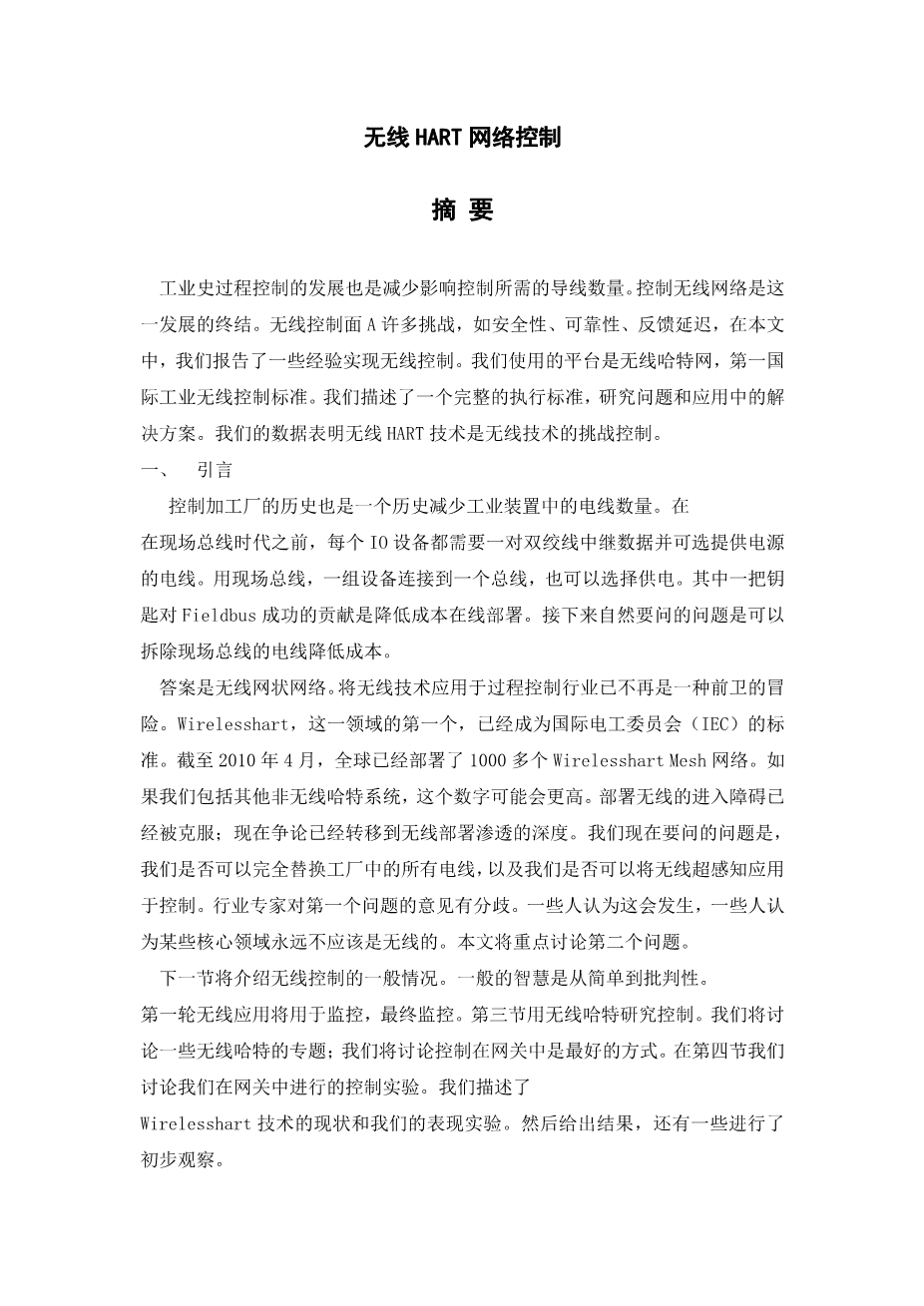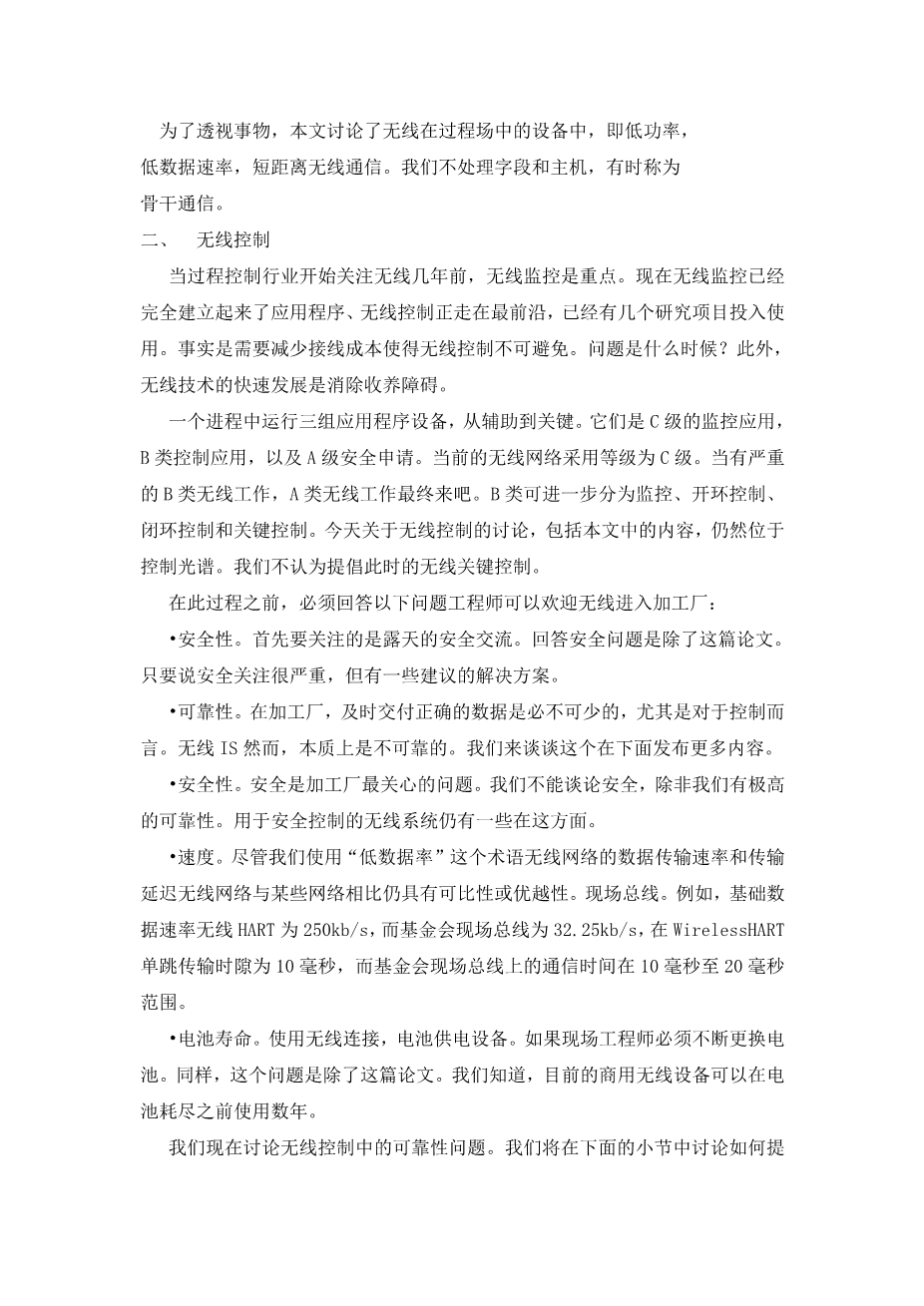Control over WirelessHART Network
Abstract
It has been observed that the history of industrial process control development is also a history of reducing the number of wires necessary for effecting the control. Control over wireless is the end of this evolution. Wireless control faces a lot of challenges such as security, reliability, feedback latency, battery longevity, etc. In this paper we report some experience with implementing control over wireless. The platform we use is the WirelessHART mesh network, the first international industrial wireless control standard. We describe a full implementation of the standard and study the issues and solutions in its application. Our data suggest that WirelessHART technology is up to the challenge of wireless control.
Ⅰ.INTRODUCTION
The history of controlling a process plant is also a historyf reducing the number of wires in the industrial plant. In thepre-fieldbus era, each IO device requires a pair of twisted wires to relay the data and optionally provide the power. With fieldbuses, a set of devices are connected to a single bus, which also optionally supplies power. One of the key contributors towards fieldbuses’ success is the cost reduction in wire deployment. The natural next question to ask is if we could remove the wire for the fieldbuses as well to further reduce costs.
The answer is wireless mesh network. Applying wireless in the process control industry is no longer an avant-garde adventure. WirelessHART, the first in this field, has become the standard of International Electrotechnical Commission (IEC). As of April 2010, there are already more than a thousand WirelessHART mesh networks deployed all over the world. If we include other systems that are not WirelessHART, the number could be even higher. The entry barrier for deploying wireless has been overcome; the debate has now shifted to how deep the wireless deployment penetration is. The questions we ask now are if we could completely replace all the wires in the plant, and if we could apply wireless beyond sensing to control. Industry experts are divided in their opinions on the first question. Some believe it will happen, some argue that certain core areas should never go wireless. This paper will focus on the second question.
The next section looks at control with wireless in general. The common wisdom is to go from the simple to the critical. The first round of wireless applications will be for monitoring, and eventually supervisory control. Section III studies control with WirelessHART. We shall discuss some topics specific to WirelessHART; we shall argue that control in the gateway is the best way to go. In Section IV we discuss our experiment with control in the gateway. We describe thestate of the WirelessHART technology and how we perform the experiments. The results are then presented and some preliminary observations are made. Section V concludes the paper.
To put things in perspective, this paper talks about wireless among the devices within a process field, i.e., the low power, low data rate, and short distance wireless communications. We do not address the wireless communication between the field and the host, which is sometimes referred to as backbone communication.
Ⅱ.CONTROL OVER WIRELESS
When the process control industry started looking at wireless a few years ago, wireless monitoring was the focus. Now that wireless is fully established in the monitoring applications, wireless control is coming to the forefront and several research projects have been devoted on it [7][8][9][10]. The fact is that the need to reduce the wiring costs makes control wireless inevitable. The question is when. Besides, the fast progress in the wireless technology is removing the adoption barrier.
There are three groups of applications running in a process plant, ranging from auxiliary to critical. They are Class C applications for monitoring, Class B applications for control, and Class A applications for safety. The current wireless adoption is at the Class C level. While there has been serious work on wireless for Class B, wireless for Class A will also come eventually. Class B could be further divided intosupervisory control, open loop control, close loop control and
The following issues must be answered before the process engineer can welcome wireless into the process plant:
- Security. The first concern is the security of open air communication. To answer the security question is beyond this paper. It suffices to say that the security concern is serious but there are some proposed solutions.
- Reliability. In a process plant, timely delivery of correct data is essential, especially for control. Wireless is, however, inherently unreliable. We shall talk about this issue more in the following.
- Safety. Safety is the topmost concern in a process plant. We could not talk about safety unless we have extremely.
We now address the reliability issue in wireless control. We discuss how to increase reliability in the following subsection; in the subsequent subsection we discuss how to adapt control for unreliable communication.
A.Increase Wireless Reliability
The premise is that if wireless communication can be improved to as good as that of the fieldbuses, then the reliability problem will no longer be an issue. Reliability includes many aspects, such as availability, survivability, dependability, integrity, safety, performability, etc. We shall use WirelessHART as the example.
The WirelessHART standard achieves high reliability through diversity over several dimensions:
- Time. All non-broadcast messages require ACK within the timeslot. Retry is employed on failure.
- Space. WirelessHART network uses a mesh topology;
- each end-to-end pair must have at least 2 live paths.
- Frequency. The WirelessHART standard
剩余内容已隐藏,支付完成后下载完整资料


英语译文共 10 页,剩余内容已隐藏,支付完成后下载完整资料
资料编号:[445641],资料为PDF文档或Word文档,PDF文档可免费转换为Word
原文和译文剩余内容已隐藏,您需要先支付 30元 才能查看原文和译文全部内容!立即支付
以上是毕业论文外文翻译,课题毕业论文、任务书、文献综述、开题报告、程序设计、图纸设计等资料可联系客服协助查找。


